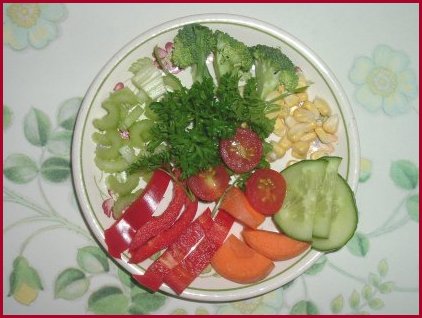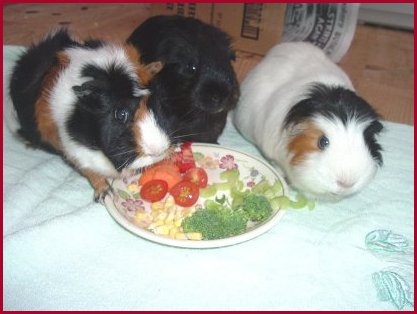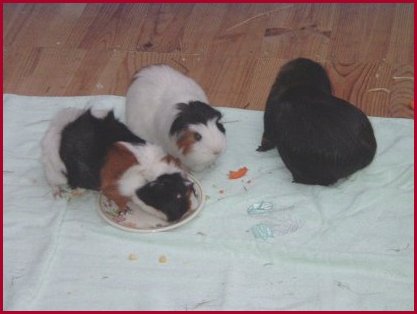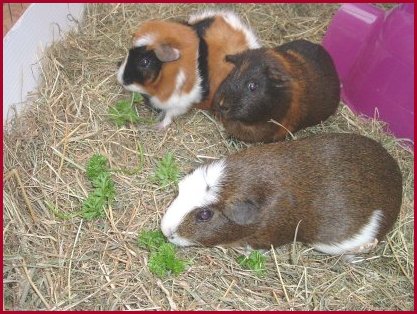A Chart of Foods Guinea Pigs Can Not Eat
Vitamin c is especially important in a guinea pigs diet. Unlike many animals, guinea pigs can't produce their own vitamin c. A deficiency of vitamin c, could lead to scurvy and also loss of resistance to other diseases. To find out more, please visit Guinea Lynx: Scurvy Although good quality pellets contain vitamin c, its not an adequate amount for a guinea pig, their diet needs to be supplemented with vitamin c vegetables. I only use a vitamin c tablet as a supplement, if one of my guinea pigs is poorly. I always have Oxbow's 50 mg vitamin c tablets in their first aid kit. They can be halved into 25 mg daily. I don't dissolve it into their drinking water, but add it to a little water, using a 1-ml syringe to administer the vitamin c. For more information, please read my Hand Feeding page, to find out how you use a syringe correctly, when giving liquid or food to a guinea pig. List of vegetables and fruits
Here is list of fresh foods that are suitable for guinea pigs and are very popular with my little group. Remember every guinea pig is different, some guinea pigs may like certain foods like carrots or kale, but may turn their noses up at other foods like baby tomatoes or celery. Like us humans, they all have likes and dislikes.
My guinea pigs have a good variety of fresh foods, usually around 4 types of fresh food daily. I usually give 2 types of vegetables in the morning and 2 in the evening, so they have something tasty to look forward to twice daily. They also occasionally get the odd treat in the middle of the day, like a small piece of apple or a piece of refreshing cucumber. Along with the list, I've also included a rough guide about the amount that I give my guinea pigs and how often. Some fresh foods are also seasonal or may just not be available to buy every week.
Pease note: Remember to remove any uneaten fresh food after roughly an hour. Fresh grass especially wilts very quickly so anything your guinea pig doesn't eat straight away, take out of the cage and throwaway. Remember all fresh foods must be washed and any grass/garden plants must be pesticide free.Further down the page I will explain why certain vegetables and other plant material need to be limited or avoided completly.
All vegetable and fruit portions listed are for one guinea pig.
Red or Green Bell Peppers: One slice of a whole pepper, given daily, remove seeds. My favourite fresh food for guinea pigs and is loved by most guinea pigs. Very high in vit c, especially the red, but all colours have high vit c content. Pease note: Bell peppers are not to be confused with red hot chilli peppers which are a totally different food and should never be given to guinea pigs.Broccoli: Half a floret, including the stalk, twice weekly.
Kale: Two to three small leaves, twice weekly. Not always available in our supermarket.
Carrot: One baby carrot or a small slice of a large carrot, every other day.
Romaine Lettuce: One large leaf, every other day. Never give guinea pigs iceberg lettuce, its not nutritious and it can give them an upset tummmy and diarrhoea.
Celery: One 1/4 of a stick, weekly. Very stringy so needs to be chopped up into small pieces to avoid piggy choking.
Dandelion Leaves: Two or three, average size, twice weekly. A seasonal food during spring and summer.
Fresh Grass: Small handful, three to four times weekly. A seasonal food, spring, summer and autumn. Sometimes my piggies go outside to eat fresh grass for themselves on warm sunny days. Never put guinea pigs out on wet grass, always make sure the grass is dry and never use grass that's been cut by a lawn mower. When spring has arrived and your grass has started to grow, just give your piggies a small amount of grass to begin with so their tummies adjust. More about saftey tips below.
Baby Tomato's: One baby tomato or small plum tomato, twice weekly. Remember to remove the poisonous tomato top ( green part ) If using a slice from a larger tomato, remove seeds.
Cucumber: Very little nutritional value, but has high water content and is loved by most guinea pigs. One slice, include the outer layer which is their favourite part. Given every other day. Cucumber is really appreciated by guinea pigs in hot weather, it acts as a liquid and is nice and cool. A little like us enjoying an ice lolly.
Parsley: A few sprigs , given weekly. Very high in calcium so should be limited if your guinea pig is prone to developing bladder stones.
Apple: One small slice, include peel, give weekly, remove core and pips. Royal gala variety is a favourite. Many fruits are full of natural sugar and have fruit acid. To avoid your guinea pig getting a sore mouth, cut all fruit into small pieces and just give as an occasional treat because of the high sugar content.
Pear: One small slice, include peel, give weekly, remove core and pips.
Seedless Grapes: One or two, must be seedless, give weekly.
Satsumer Pieces: One or two segments, remove rind and pips, give weekly. You can give a little of any orange citrus fruit.
Corn on the Cob: A recent new food. I'm unable to find corn on the cob with outer leaves, but the leaves can be eaten by guinea pigs. Roughly a dozen tiny segments, twice weekly.
As an extra treat, I occasionally make a veggie pignic for my guinea pigs. Here are Jasmine, Jake and Sweetpea enjoying a veggie pignic that their mum 'The Chef' prepared for them.

Ingredients, small amounts of cucumber, red bell pepper, corn, broccoli, carrot, baby tomato, parsley and celery.

Sweetpea Jake and Jasmine tucking in, but stop for just a moment to have their photo taken!

Restaurant now closing, its getting quite late and Sweetpea is just reassuring herself that the plate is indeed empty.
More information about fruit and vegetables.A few vegetables need to be given in moderation or just given as an occasional treat. Cabbage is quite a gassy vegetable and has been known to cause bloat in guinea pigs when fed in large quantities. Make sure any cabbage given is dark green. Broccoli, kale and cauliflower are also related to the cabbage family, so they need to be given in small doses too. Some fresh foods need to be avoided completly, which include, rhubarb and potatoes which are poisonous if sprouted or green. Some vegetables are high in calcium, so if your guinea pig is prone to bladder stones, limit the amount. As long as you remember a golden rule when feeding fresh foods to guinea pigs, every thing should be given in moderation. Further Reading
For more information about vegetables and fruit, please visit the following links. Guinea Lynx: Vegetable Chart An excellent page that gives you information on calcium, phosphorus, water and vitamin c content in vegetables. On the left-hand menu, you'll also see a chart for fruits. Pigjes Homepage: Guinea Pig Shopping List An excellent page about suitable vegetables and fruits for guinea pigs, includes pictures. Fresh food preparation and safety
I store the vegetables in our pantry as its quite cool in there. Salad of course, is kept in our fridge. I just leave any salad I'm using for my guinea pigs, out of the fridge for a little while, before serving. Guinea pigs can have an upset tummy and diarrhoea, if they eat fresh food that is too cold. Never give vegetables from the freezer. Disregard any food that is going slightly brown/yellow or is wilting. Feeding food that isn't fresh could also upset their tummy and give them diarrhoea. Remember to remove seeds or pips from bell peppers, large tomatos, apples etc. I limit my guinea pigs fruits and just give fruit as an occasional treat, as they are high in sugar. Also, remember to cut celery up into small pieces as its stringy and could make piggy choke.
Always wash any fresh food first, you don't have to shake the excess water out, its an ideal way to give your guinea pig extra water. Use a clean work surface and a clean knife for cutting up the vegetables and fruit. Any uneaten fresh food, needs to be disregarded after a couple of hours, less time in warm weather.
As a family, I find we are eating more healthier since sharing our life with guinea pigs and hardly any foods gets wasted. I'll update this page whenever my guinea pigs have tried a new food that they enjoy.
Introducing a new foodGuinea pigs have a sensitive digestive system and its easily upset, so always introduce any new food slowly. Just give them a very small piece and if they like it, just keep increasing the amount a little for the next serving. If they turn their noses up at the new food, don't give up at the first hurdle, just keep trying. Sometimes, guinea pigs will follow their cage mates lead and try a new food, only when they see their cage mate tucking in. Sweetpea and Peachy will especially try anything and often their cage mates will follow suit. Sometimes though, guinea pigs will just refuse to eat the new food, even after a whole week of trying.Grass and garden plants
You can of course, give your guinea pigs fresh grass from your garden. Never take grass from a park or the near the roadside, you never know if a dog has fouled the grass. Make sure no chemicals have been used in your garden and never use grass that's been cut by a lawn mower. Remember fresh grass wilts very quickly, so only leave it in the cage for around 20 minutes. Most guinea pigs will eat it straight away. Remember you can feed your guinea pig certain garden plants like clover leaves and dandelion leaves. But for your guinea pigs safety, please visit Guinea Lynx: Poisonous Plants to read about garden plants. In the left-hand menu, there is also an excellent page on garden plants that are suitable for guinea pigs. Remember to keep all your house plants out of reach.
Another excellent site to visit is
Galen's Garden which has information on herbs and wild plants used for medicinal purposes. Again, always know exactly what you are giving to your guinea pig, as the saying goes, if in doubt, leave it out.
Here is Squeekie, Clover and Peachy munching on some lovely fresh parsley. I think Clover has fitted too much in at once, look at those lovely chubby cheeks!
A Chart of Foods Guinea Pigs Can Not Eat
Source: https://jackiesguineapiggies.com/fruitandveg.html